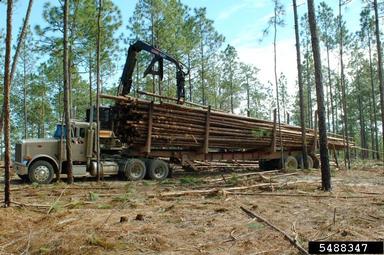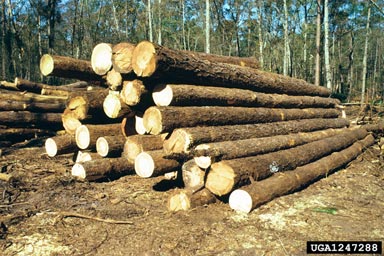Contact
Dr. Michael Blazier
Dean of College of Forestry, Agriculture & Natural Resources
Phone: +1 8704601152
Email: Blazier@uamont.edu

How to Market Your Arkansas Timber
Have you thought about how to market your timber? Whether a landowner is managing a pine stand to produce an income or managing for some other purpose, for biological reasons it will become necessary to thin the stand at some point.
If the stand is held to produce an income, it will be necessary to harvest it at some point to recover costs and collect the profit. Both of these events offer an opportunity for the landowner to generate an income from the stand. Maximizing the income from the thinning or harvest requires careful planning.
The steps taken to maximize the income from your timber sale are referred to as "marketing" timber.
Successful marketing involves understanding the forest products you are selling.
What forest product can be milled from this tree? Pulpwood? Sawtimber? Utility poles? Veneers? Flooring? Each of these product classes has its own value and must go to a mill specific to that product. Access to those mills, those markets, will impact the stumpage value of your timber.
The Cooperative Extension Service has a fact sheet called What Should I Know About Selling My Timber? that explains some of the basics of selling timber.
How do you market timber?
First, it is necessary for the landowner to determine the volume (or weight these days) and value of the timber to be sold. Two decades ago, most pine timber was sold by volume, and you will often still hear volume mentioned; but the reality is that pine timber is now sold mainly by weight. A professional forester, or skilled landowner, will divide the trees to be sold into product classes based on the specifications for the trees going to each product class. The value of each product class can then be estimated separately as outlined below.
The fact sheet Landowner's Guide to Determining Weight and Value of Standing Pine Trees explains how weight and value of pine trees are estimated. A similar fact sheet for hardwoods is also available.

Trusting one buyer's estimate of the weight and value of your timber is not a good idea.
Not all buyers sell to the same mills or have the same skills at maximizing the value of the timber they harvest. Some buyers may already have enough work and may underestimate the weight and value your timber compared to someone who needs another timber purchase to complete his work schedule for the next year.
What impacts the value of timber?
- road access
- distance to mills for the various products
- size of the tract
- season of the year
- weather
- equipment available to the logger.
What should I do to sell my timber?
- Get bids from several buyers.
- Hire a consulting forester to cruise your timber to determine how much is present and, in the case of thinning, how much needs to be removed.
- Be aware that the timber weight and value the forester provides to you will be an estimate. The final results of the sale will almost certainly be different.
- The fact sheet Consulting Foresters for Private Landowners explains what a consulting forester can do for you and how to hire one.
Estimate the value of your timber
Once you have an estimate of the volume (or weight) of timber to be sold in each product class, you will need to estimate the value of the timber, if your consulting forester hasn't done that for you already.
An estimate of the total value will start with a value per ton for the timber in each product class you will be selling. Note that the value will be different for each product class. For purposes of selling timber in Arkansas, the many species found in a forest are usually lumped as pine, oak, or mixed hardwoods. The fact sheet Timber Price Reporting: How Do I Get a Report and What Does It Mean? explains how to determine the average unit value of timber in your area.
The price reports referenced in the fact sheet are available from the Cooperative Extension Service on this web page (Timber Price Reports). Be aware that the latest prices reported in these guides are for the previous quarter. They probably do not accurately reflect current timber prices, but they are the most current reports available.
Find a buyer
Dealing with only a single buyer is not the most effective strategy for getting the best price for your pine timber. If you already have a good relationship with a buyer you trust, you may do well dealing with that one buyer. However, most landowners rarely sell timber and don't have a long term relationship with a buyer. This is another area where a consulting forester can be useful to you. Your consulting forester will have a list of buyers in your area and will know which buyers deal with the products you are trying to sell. This is especially true with products such as utility poles and hardwood flooring.
A lump sum sale is the most appropriate marketing strategy for most landowners.
A lump sum sale strategy with payment due at the time the bid is accepted provides two advantages to the landowner. First, the landowner doesn't have to figure out the weights and values of the various forest products involved in the sale. Each bidder will make his own estimate at the time the bid is calculated. Second, some of the risk is shifted from the landowner to the timber buyer. This is appropriate because landowners usually have little understanding of the risks involved in selling timber and don't know how to mitigate those risks. Timber buyers, on the other hand, understand the risks and know how to manage them.
Of course, one important aspect of marketing your timber is to use contracts when you buy services such as timber cruising or timber marking and when you sell timber. The fact sheet Forestry Contracts explains why and how to use contracts in timber marketing.
That's a brief overview of timber marketing. Timber marketing, like any marketing, is a skill best learned through experience. Most landowners sell timber once or twice in a lifetime and have little opportunity to develop the necessary skills. A consulting forester can provide the skills necessary to conduct a profitable and safe timber sale.
If you have questions about how to conduct a timber sale or get help from a consulting forester with your timber sale, contact your county extension agent or Arkansas Forestry Commission county office for additional information. If you'd like to talk to someone about marketing forest products, please contact your county Extension agent.
Publications
- Consulting Foresters for Private Landowners
This fact sheet explains how to find and hire a consulting forester.
- Forestry Contracts
This fact sheet explains why and how to use contracts when selling timber or hiring service vendors.
- Landowner's Guide to Determining Weight and Value of Standing Pine Trees
This fact sheet explains how to determine the value of your timber.
- Timber Price Reporting: How Do I Get a Report and What Does It Mean?
This fact sheet explains how and where to get a timber price report for your area.
- Timber Theft . . . No Laughing Matter
This fact sheet explains how to secure your timber from theft.
- What Should I Know About Selling My Timber?
This fact sheet explains how to conduct your own timber sale.